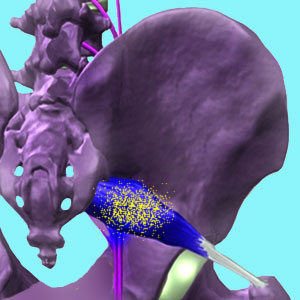
Piriformis ischemia is a source of chronic pain that can be created rarely by structural reasons and commonly by psychogenic motivations. Ischemia is a diabolical process, since it starves cells of the blood flow they require in order to function properly and live. While structural reasons for ischemia can be diagnosed via various types of specialized testing, psychogenic examples generally go undiagnosed and therefore ravage patients for long timelines, causing them to undergo various treatments which unfortunately never get to the heart of their painful process. The most common result of ischemia is long-term pain that defies therapy and often seems implausible in its expanse and ferocity.
The Cure Back Pain Network has been writing about the growing incidence of mindbody ischemia for over 12 years now. Our research and clinical experience has proven to us that regional ischemia is one of the most common sources of chronic pain and directly explains many profiles where pain seems so stubborn and therapy-resistant.
This important patient guide reports on the condition known as piriformis muscle ischemia. We will discuss why and how ischemia occurs and the effects of the disorder on the patient.
Piriformis Ischemia Mechanism
Ischemia is a silent and often difficult-to-detect process by which areas of the body are starved of nutrients, the ability to metabolize waste and most importantly, oxygen, by a reduction in blood flow to the targeted anatomical area. Ischemia can affect particular tissues, but is usually a regional process that affects all of the cells in the targeted zone of the body.
All cells require nutrients, the ability to metabolize waste and oxygen in order to live and function. However, some cells are much more resistant to ischemia than others. Bone and most connective tissues cells are highly resistant to oxygen deprivation and will take a long time to suffer full negative effects from ongoing reduced blood supply. Muscle cells are still very durable and resistant, but will certainly show evidence of ischemia effects much faster. Nerve cells and other specialized cells are affected dramatically and almost immediately by reduced oxygenation, suffering terrible and occasionally catastrophic reactions to decreased blood flow.
Ischemia can occur due to compression of blood vessels, build-up of plaques within blood vessels, dysfunction of blood vessels and various disease processes. These types of ischemia can generally be diagnosed with specialized testing that can measure blood flow to various regions of the body, although it may take time to narrow down the focus on ischemia as a possible source of symptoms. However, most ischemia that we see is not motivated by disease, degeneration of other circulatory vessel pathology, but instead is purposefully enacted by the mind. This psychogenic piriformis ischemia has become the subject of intense scrutiny, since it is the missing link that helps to finally and logically explain the epidemic of chronic pain that has exploded rather mysteriously in the healthcare sector in the past few decades.
Ischemia Symptoms
Reduced oxygenation will elicit various effects, depending on what type of cell is affected, the degree of oxygen deprivation suffered and how long the condition persists. These 3 criteria present a highly variable picture of potential symptomology that ranges from mildly uncomfortable to disabling, and can explain both acute flare-ups of symptoms, as well as chronic health issues.
Focusing on the piriformis muscle, ischemia can cause the muscle to suffer pain directly, such as that which would be expected from soft tissue injury or RSI. This is why many cases of piriformis pain are diagnosed as stemming from injury or RSI, even though there is no solid evidence of such trauma or incidental evidence of past trauma.
Ischemia can also cause the piriformis muscle to spasm, creating the condition known as piriformis syndrome. Regardless of the anatomical positioning of the sciatic and/or pudendal nerves, a spasming piriformis muscle can compress these crucial nerves and cause terrible symptomology. It is a well known scientific fact that reduced oxygenation of muscles causes cramping and dysfunction, which is exactly what is occurring in piriformis syndrome. Ischemia provides the most common and logical source of spasms in an otherwise healthy muscle and is often exacerbated when the patient also demonstrates atypical sciatic nerve positioning in respect to the piriformis muscle. Pseudo-sciatica is well known as a common ischemia pain syndrome and the variety that is created by piriformis-enacted compression of the body’s largest nerve is certainly no exception to this rule.
We see many instances where piriformis spasm is correctly identified as the correct mechanism of pain, but the underlying reason of mindbody ischemia is not ascertained. This is why patients never understand why their piriformis is spasming or how to truly end the pain once and for all.
Piriformis Ischemia Causes
As noted above, some ischemic syndromes result from anatomical damage, incapacity or disease. In essence, the circulatory vessels simply are not working correctly and a reduced amount of blood is therefore reaching its intended destinations. This destination might include the piriformis muscle, although it is unlikely that only the piriformis will be affected by ischemia. These conditions can be positively diagnosed by qualified physicians, which is why patients are advised to be certain that the leader of their care team is indeed a doctor with the experience to verify or rule out such potentially catastrophic causes of pain.
Psychogenic varieties of ischemia result when the mind is actively trying to defend the consciousness against suppressed or repressed psychoemotional issues that seek to come to light. It is the nature of these emotional sensitivities to desire conscious recognition and the goal of the subconscious to keep them jailed for eternity. When life circumstances assist these dark and disturbing issues in finding conscious recognition, the mind might choose to begin a defense mechanism in order to focus the consciousness on pain, rather than risk it discovering the repressed stored-away undesirables. Since pain is such a wonderfully effective way to fully immerse the consciousness in “right now”, there is simply no way for these issues to gain the attention of the conscious mind, which is now completely preoccupied with pain. This is a simplistic explanation of a much deeper topic. However it is sufficient for patients to understand if they are suffering piriformis symptoms and have doubts as to the structural plausibility of their pain or have not found relief, despite indicated treatment.
We have written vast amounts of material on the full scope of ischemia throughout the sites of The Cure Back Pain Network. We cover all the important points of this conversation, including why mindbody ischemia is not generally diagnosed and treated by doctors, why it is so difficult to identify and why it does not respond to the traditional treatment often used to battle it. In order to get a full appreciation of the condition please use our site search to query ischemia and/or oxygen deprivation. The more you read on this subject, the better prepared you will be to face the very real possibility of suffering from ischemia in the piriformis muscle and/or elsewhere. It should be noted that ischemia is the root cause of many cases of chronic back pain, carpal tunnel syndrome, TMD, knee and hip pain, sciatica, gastrointestinal disorders, headaches and other treatment-defiant conditions. If you tend to express these pain syndromes, as well, you really owe it to yourself to fully research ischemia now.
Our Cure Back Pain Forever Program is effective for all types of chronic pain caused by ischemia. In fact, the program focuses on mindbody medicine and has received many accolades from notable doctors and healthcare organizations worldwide.
Piriformis Pain> Psychosomatic Piriformis Pain > Piriformis Ischemia





